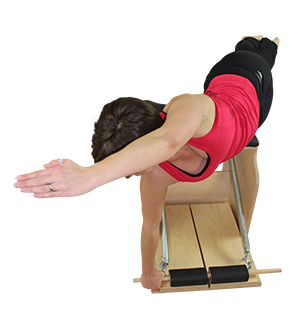Centerworks® “Secret” Training Tips for Mobilizing the Ribcage
Part Five: Multi-Directional Movement of the Spine

Here it is…the grand finale for our discussion on “secret” training tips to mobilize the ribcage for a healthy spine and get the upper back to move more easily. When you get to more advanced exercises or sport and athletic endeavors the body must be able to move with ease in many directions at once! From a basic Pilates exercise standpoint, this would be practicing exercises like the Saw in Matwork. You are both twisting and bending the spine and ribcage have to both rotate and flex to do the exercise well.
There are many complex exercises in the Pilates exercise repertoire that give you an opportunity to practice multi-directional movements. But if the spine and ribcage are not moving well in the basic directions (flexion, extension, lateral bending, and rotation) we can’t expect the body to cooperate and coordinate great multi-directional movements!
Spending time focused on the basics is critical for progressing safely to more complex movements and exercises. And sometime practicing exercises that take the body in multiple planes of movement is exactly what the body needs to free things up for better movement in the simpler directions! It can be a dilemma to “bust a move” and go wild or proceed with caution.
So how do you decide which is more appropriate for you – sticking with the basics or pushing your body for complex, new ranges of movement? I suppose this is where the expert eye and opinion of YOUR Pilates teacher can come in handy. Having someone that knows your body’s movement habits and any past injuries or accidents that might need to be taken into consideration, who can be by your side to challenge and correct you while you’re progressing, can be the difference between having fun with a new challenge, and getting hurt in the process of pushing your boundaries in multiple new directions.
There are some complex multi-directional exercises, like the Saw which are considered safe for beginners, but others like Snake-Twist on the Reformer, or Teaser-Twist on the Chair (as shown above in the photo for this article), which would be best to be practiced after years of study and a great foundation of good basic movement habits under your belt.
Personally, I like to proceed with caution and focus on helping my clients get solid basics under their belt. If you’re in-tune with your body and can really find and feel what’s working with basic exercises in all planes of movement, it becomes very easy to leap forward into more challenging “advanced” moves and not get hurt.
What are key things you can focus on to stay safe, avoid potential injuries and progress to multi-directional exercises to mobilize the spine and ribcage?
- Use your breath to support moving the body. If you’re not sure of the breath pattern that will best help you execute a complex exercise. Stop, take a moment, and figure it out. “Riding the Breath” can play a critical role in having the joint space necessary to move in multiple directions.
- Determine the “anchor point” for each exercise. A strong and solid anchor point will give you a specific part of the body to move away from and return to.
- Plot out a plan for progression, from the simplest version of an exercise or movement pattern to the most challenging and complex. Then follow the plan, knowing that each exercise is helping you progress to the next level.
There is more to it than this – but as you’re plotting out your progressions, try to look for exercises that fall into the following patterns for movement of the spine and ribcage.
- Flexion and Extension
- Flexion and Rotation
- Extension and Rotation
- Side Bending and Rotation
Then we can also add to this list of complexities what’s happening for hip mechanics, arm & shoulder mechanics, and/or feet because all of this is what challenges the brain and body for understanding better movement patterns! There are endless opportunities (and exercises) for discovering different ways to move the body, articulate the spine, and mobilize the ribs!
If you can’t come up with a specific Pilates exercise that works a category, create a new “fundamental” to help you start easy and work to more of a challenge. (Chances are there probably are a few exercises in the Pilates repertoire, but they may not be in your repertoire at the moment!) If you’ve ever taken jazz, modern, or Middle Eastern dance classes there are tons of warm-up exercises and dance moves that require rib isolations. If you can move your ribs, you can move your spine! For Pilates our goal is not to isolate the rib and spine movement, but to incorporate it into freely moving and using the whole-body for healthy functional movement habits.
Here’s an example of plotting out a path for developing the strength, flexibility, and body awareness for multi-directional movement for the spine and ribcage:
The Movement: Side Bend and Rotation
END Point GOAL Exercise: Advanced Mat Exercise – Twist II
Path for Progression:
Basic Progressions (included in a normal training session along with other whole-body exercises.)
- Front Plank (Core Strength and learning how to support the body on the arms.)
- Long Stretch (Upper body/core strength and shoulder mechanics)
- Pull Straps & T w/out spine extension (Upper body strength and shoulder mechanics)
- Side Lying Arm Waves on the Spine Corrector (to train healthy shoulder mechanics)
- Simple Seated Twist (to learn sequential rotation of the spine)
Intermediate Progressions (These exercises would not ALL be in one workout – but would be on the list of targeted exercises to incorporate into weekly workout programs for training over several months (or longer) to reach the ultimate goal of executing the Advanced Mat Side Plank with a Twist exercise.)
- Mermaid on the Spine Corrector (side torso strength and shoulder mechanics)
- Side Lying Twist on the Spine Corrector (to learn the sequence of action for the rotation)
- Side Lying Leg Series (esp. Lift & Lower, Passe, Side Leg Lift Parallel, and 2 Leg Lift for outer hips strength needed to stabilize balance for side plank)
- Mermaid with the Push Thru Bar (Lat strength and shoulder mechanics + lateral movement of the spine)
- Mermaid Kneeling on the chair. (Lat strength with lateral movement to support the body and keep shoulders safe)
- Leg Pull Back-mat / Long Back Stretch arms-Cadillac/ Long Back Stretch-Reformer (upper body strength & conditioning)
- High Chair – dips / Cadillac (pull-ups) (upper body strength)
- Matwork – Kneeling Side Legs – Lift & Lower, Kick Front & Back, Little Circles (Lateral – 1-arm Side support / Hip & leg strength)
Advanced Progressions
- Side Plank – Lift & Hold (supported on forearm)
- Twist I – Lift & Hold (supported on 1 arm)
- Twist I – Lift & Lower with side arm wave overhead.
- Twist II – Lift & Hold + Spiral Twist forward
- Twist II – Lift & Hold + Spiral Twist forward, center, backward, & center
(Then additional variations can be added (pike version, head turns, ect…)
This is certainly not the only path of progress to get to a great Side Plank – Twist II. But hopefully this example has provided you some food for thought as you determine the complex “GOAL” exercises in your Pilates training program and plot out safe and smart progressions to help you get the strength, flexibility and body control to achieve your exercise goals.
Enjoy healthier movement habits and freer functional movement for your spine, ribcage and ultimately your whole-body by improving your body awareness, and plotting a path to mobilize the ribcage for better movement of the spine during your multi-directional Pilates exercises, sport, and daily-life activities.
********
Check out the entire Mobilizing the Ribcage Series:
- Pilates Training Tips to Mobilize the Ribcage for Better Functional Movement
- Spine Flexion
- Spine Extension
- Spine Rotation and Twisting
- Side Bend


0 Comments